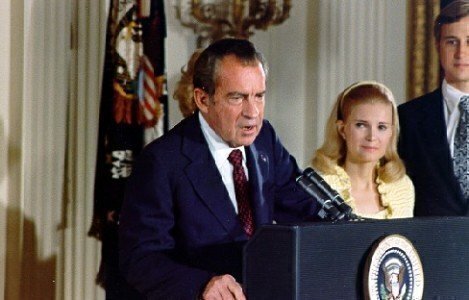On July 28, 1974, the House Judiciary Committee passed the first of three impeachment articles against President Richard Nixon. Although a final House vote never took place along with a Senate trial, plans were being made for these events.
 However, President Nixon resigned on August 9, 1974 after a Supreme Court decision compelled Nixon to released unedited Watergate tape transcripts that included incriminating evidence.
However, President Nixon resigned on August 9, 1974 after a Supreme Court decision compelled Nixon to released unedited Watergate tape transcripts that included incriminating evidence.
The House committee had debated the impeachment articles for about seven months, and the group approved the first article by a 27-11 vote, on July 28, 1974. On the same day, the Washington Post reported some details about what would happen down the road if Nixon fought the charges.
The Judiciary Committee still needed to write a report for the full House about the charges and get the House Rules Committee to set debate rules. Two weeks of debate were expected under the rules, with the final impeachment vote expected near August 24, 1974. (The Post said that House member Tip O’Neill believed the Nixon impeachment articles would pass a full House vote by at least 50 votes.)
If the House approved any of the three articles, President Nixon would have been provided time to form a defense, with the Senate trial lasting about two months.
The Post also said the Senate leaders Mike Mansfield and Hugh Scott were set to meet the next day to start planning for a possible trial.
But on August 2, the House Rules committee said that the start of the floor debate would be later, on August 19, with the full report due to all House members on August 8, 1974 – the day that Nixon would later announce his resignation to a national audience.
In a 1985 interview, the former Secretary of the Senate, Francis Valeo, spoke about the Senate’s tentative plans.
Valeo said that in general, Mansfield, the Senate leader, was worried about Nixon’s behavior. “Finally, I got the order from Mansfield, but I'm sure he must have had Scott's concurrence in it, to start planning for the trial in the Senate, because it seemed to be a foregone conclusion that [Nixon] would be impeached in the House,” Valeo said.
Mansfield agreed that any trial needed to be televised, and Valeo started working with the press on credentialing and the configuration of the Senate floor. “We were prepared to go ahead with the trial. I mean, physically we had figured out what would be done by that time. But of course Nixon resigned and that changed the equations,” Valeo said.
Senate parliamentarian Floyd Riddick also started a series of meetings to revise the chamber’s impeachment rules for a possible Nixon trial. The rules were published in September 1974 after Nixon’s resignation.
James St. Clair, Nixon’s chief defense lawyer, had been expected to represent the President at any Senate trial. St. Clair had also argued the losing case in the Supreme Court about the Watergate tapes and had represented the President during the House proceedings.
Chief Justice of the United States Warren Burger would preside over any Senate impeachment trial. Burger was appointed to the Court by Nixon in 1969, but he also wrote the unanimous decision that forced Nixon to release the full Watergate tapes. House members would serve as managers to argue for the impeachment articles in the Senate.
At least two-thirds of the Senate would have needed to convict Nixon on at least one of the three impeachment articles to force his removal from office. On paper, the Democrats were at least 10 votes short of having such a supermajority on party lines, but Nixon’s advisers were already telling him in early August that the House impeachment vote was near certain and a Senate conviction was a distinct possibility.
The release of the Watergate tape transcripts on August 5, 1974, made Nixon's resignation inevitable, said the Washington Post on its front page on August 9, the day Nixon officially resigned.
“It seemed inevitable then that this would be his last week in office, yet he continued to fight back and to insist that he would not resign. On Tuesday, the President held a Cabinet meeting and told his official family that he would not resign,” the Post said. “On Wednesday, however, the end appeared near, for his support on Capitol Hill was disappearing at dizzying speed. There were demands from some of his staunchest supporters that he should resign at once.”
But on August 3, Nixon speechwriter Ray Price worked on draft remarks for an address that Nixon could give if he had decided to face a Senate trial.
“I shall see the Constitutional process through — whatever its outcome. I shall appear before the Senate, and answer under oath before the Senate any and all questions put to me there,” the speech said. Nixon apparently was never shown the draft remarks. Instead, Price worked with the President on his resignation speech several days later.
Scott Bomboy is the editor in chief of the National Constitution Center.







